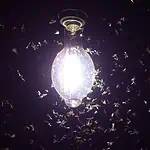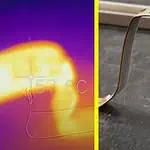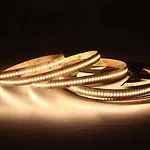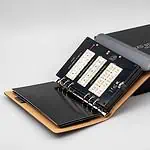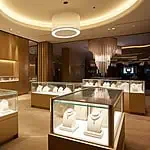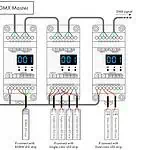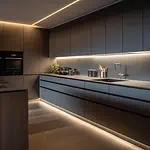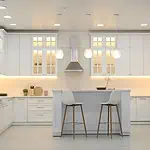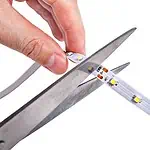Are you concerned about the visible LED strips and wires that affect the overall outlook of your decoration? If yes, hiding the LED strip is the best solution for you. But how to do that?
If you aim for ambient lighting, hiding the LED strips beneath the false ceiling is the best option. This process is often known as cove lighting. Besides, you can install them in the back or under furniture like- beds, sofas, almirahs, shelves, cabinets, etc. Mounting the LED strips behind the TV, mirror, steps of stairs, and artwork is another popular option to go for. Besides, there are more creative DIY ideas to hide the strips. Apart from just hiding the LED strips, you should also be careful about hiding the strip wires and power source.
In this guide, you will learn about the methods of hiding LED strip lights, and I will also share some creative ideas with you. Above all, I have also included the installation method and tips so you don’t get lost thinking about how to hide them while installing. So, why waste time, let’s start–
Why Should You Hide LED Strip Lights?
Let’s see some of the reasons why you want to hide LED strip lights–
Reduced Glare and Reflection: Having too bright LED strips or ones with hot spots often causes glaring issues. This can get annoying, especially when the surroundings have reflective surfaces like tiles, mirrors, or TV screens. In this case, creating an indirect illumination by hiding the LED strips can eliminate these glaring and reflecting issues.
Aesthetic Appeal: You can add a sophisticated look that elevates the space by hiding LED strips behind furniture, within architectural features, and under cabinets. It will transform the space elegantly, and you can impress the guests by showing your unique ideas.
Focus On Interior: To make the interior more attractive, hiding strip lights, which work as spotlights, is the best option. It could be any artwork or highlight your favorite items. This way, you can separate any place from the whole space and grab people’s attention.
Protects Fixture From Physical Damage: Beyond aesthetics, hiding LED strip lights serves a practical purpose, like protecting the fixture from physical damage. For instance, exposed strips are susceptible to accidental bumps, spills, and direct contact, compromising functionality and longevity. Therefore, concealing them, whether within coves, channels, or behind furniture, you can shield the delicate components from potential harm.
Ways To Hide LED Strip Lights
There are many ways you can follow to hide LED strip lights. However, I have mentioned here the most common and easiest four methods; check them out–
Method-1: Use Them Under Cover
When you don’t want the hassle of adjusting LED strip lights to the decor, you can easily cover them. You can do this with common household items, like painters, electrical, and duct tape. To begin, light the strips along the surface and use your selected tapes to fix them afterward. Also, you can use many tape layers for thicker or more secure attachments. Therefore, this process is beneficial if you want a temporary solution and like to relocate them around when needed.
Method 2: Hide Them Within Your Interior Decor
The easiest method to hide the LED strips is to incorporate these lights into your decor. Hence, you can set strips along the edges of shelves and behind furniture that work great for accent lights. Also, it can help you create an ambient and soft glow. Besides, with this method, you can highlight specific home features. For instance, when you have a sculpture or painting you want to showcase, just install strips along the behind edge of these. It will have a remarkable effect on these surfaces.
Furthermore, this idea is perfect for highlighting architectural elements like fireplaces or cornices with strip lights. Again, LED strips contain a customized option to create a more dramatic effect. So, you can make these lights recessed or even suspended lighting built into cabinetry and furniture.
Method 3: Create A Custom Housing
If you want a permanent option, you can make a custom housing for the strip lights. You can do this by anything like building a false wall to hide them by creating cove lighting. However, when you love DIY work, it will be easy for you to build a custom house for the strip by getting help from a YouTube tutorial. Also, you can hire professionals and seek companies that provide ready-made options.
Method 4: Go For Creative Ideas
Last but not least, you can do some creative ideas to hide the strip lights to use as an experiment. It could involve activities such as draping them over doorways or wrapping them all over the furniture legs. So, for creative ways, you need to think outside the box. There are no strict rules about hiding strip lights. So, feel free to experiment before you find a perfect one.
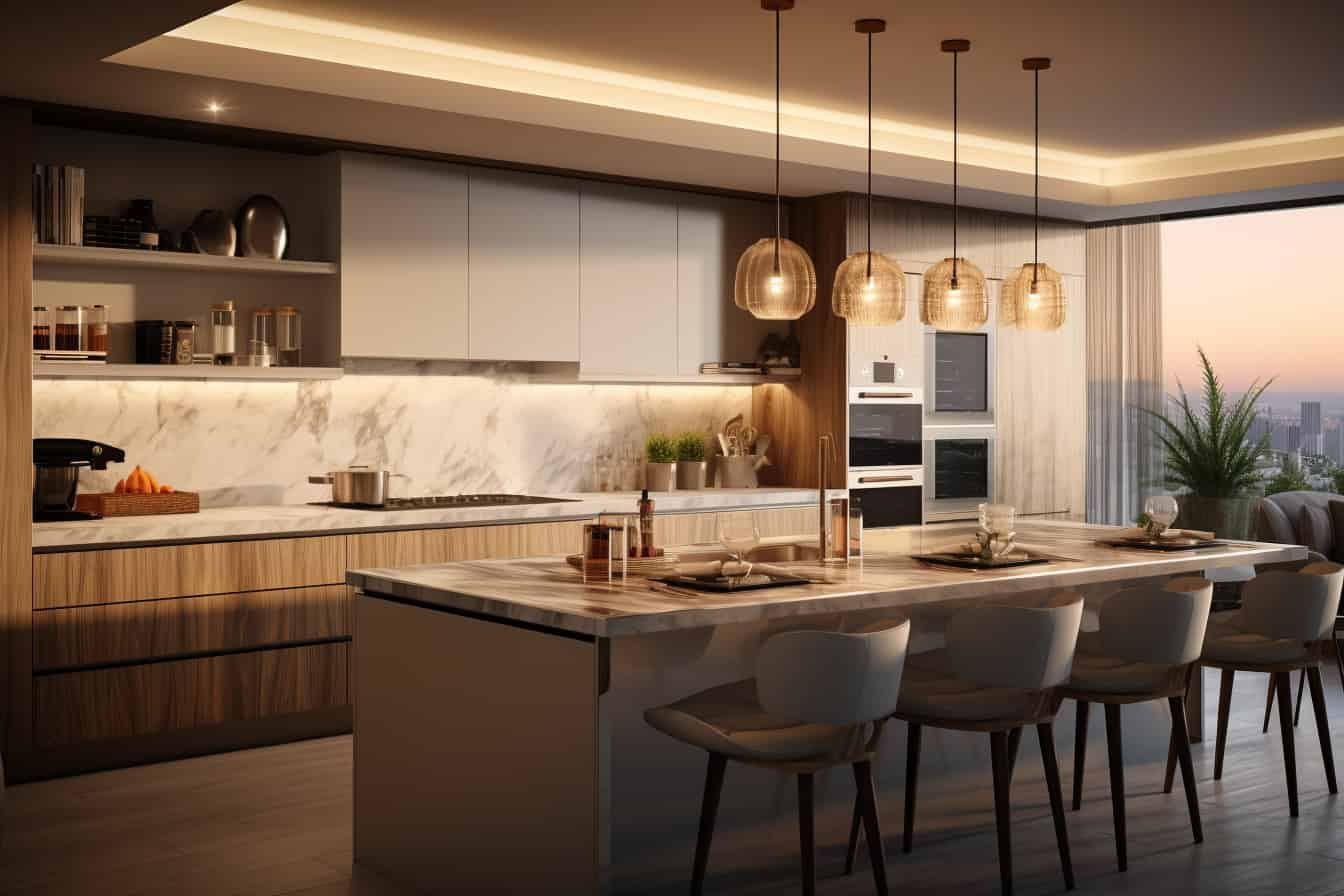
Top 17 LED Strip Light Hiding Ideas
I will share here the top 17 LED strip light hiding ideas so that you can get a seamless look without any visible wires. From the below-mentioned techniques, you can choose the one which you like most–
1. Cove Lighting
Cove lighting is the most popular way to hide LED strips that work best for ambient lighting. For this, you need to create a false ceiling around the sides of the main ceiling. You can use wooden slabs or hardboards and paint them up, matching your interior. Then, you need to insert the LED strips on the inner edges of the false ceiling. This will create an indirect illumination, casting a soft glow. Such lighting is often used to hide LED strips in bedrooms, living areas, dining spaces, or office rooms. For cove lighting, you can get help from this guide- How To Install LED Strip Lights on the Ceiling?
2. Recessed Lighting Within The Ceiling
Do you want to bring a modern and sleek look to your space? Go for recessed LED strip lighting that brings an in-build lighting solution. This will hide the LED strips within the surface and provide a finished look. However, this type of hidden installation requires professional help. You will need to install the fixture within the surface that blends in as a part of the ceiling or walls. Such ideas are ideal for bathrooms, kitchens, or other areas where a clean and basic design is wanted.
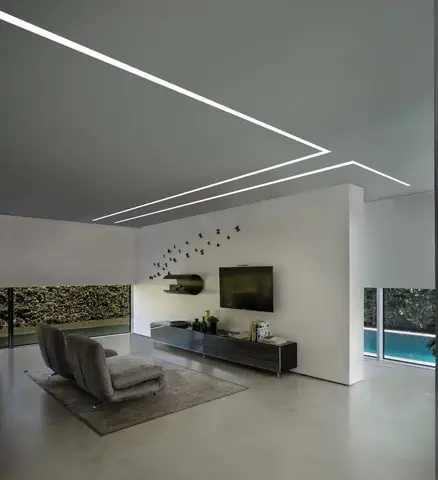
3. Trimless Installations
Trimless installations offer a clean finish by taking concealment to the next level. It involves embedding LED strips directly into the architecture and, as a result, eliminating any visible trim. You can fit recessed channels for seamless integration within ceilings, walls, and floors. Besides, such a light setting is trendy in contemporary designs, where clean lines and hidden lighting are valued. Therefore, this method conceals the light source and becomes an integral part of the architecture as it offers any space a high-end and polished finish.
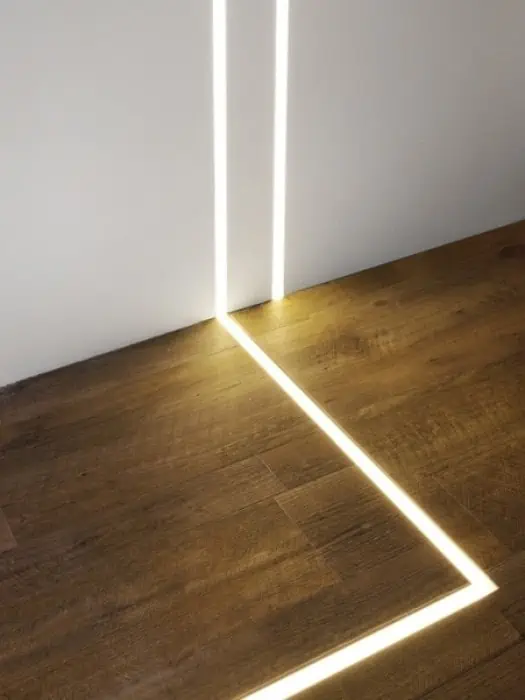
4. Under-Cabinet Mounting
Under cabinets is a famous way to hide strip lights in the kitchen and other places where cabinets are available. This could be cabinets in your closet, shelves where you put your crockeries, cabinets in the bathroom, etc. Installing the strips in the bottom of the cabinets keeps them hidden but profiles sufficient illumination for tasking. This allows you to create a subtle and practical lighting solution that helps you navigate the area. To learn more about under cabinet lighting, check this- Under Cabinet Lighting Guide.
5. Behind TV
By hiding LED strips behind the TV, you can make a dynamic effect that will increase your viewing experience. It will illuminate your wall behind the TV and create a subtle glow. Thus, you will get an extra layer of brightness in the space. So, to hide strips behind the TV, you can apply a strip-to-strip attachment to connect the LED lights to the back of the TV. After that, you can use double-sided tape to connect them to the wall. This method creates a clean look that enhances your TV setup and elevates the space’s overall ambiance.
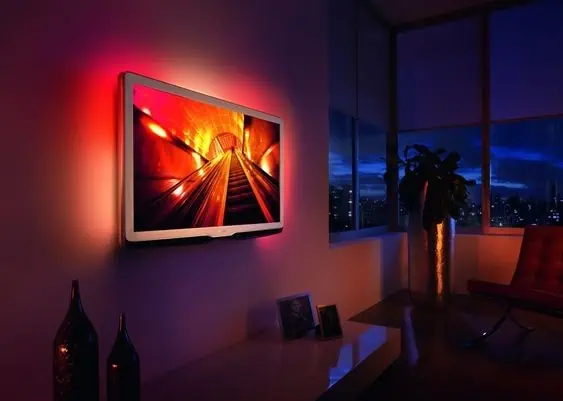
6. Using Planters And Shelves To Conceal Lights
Have you ever thought of using planters to hide the LED strips? I’m pretty sure you never thought so. Though installing LED strips beneath the shelves hides LED strips, in some cases, it’s not enough. LED strips are visible even under the shelves when seen from some angles. If this bothers you, use planters with long-hanging leaves to hide them. This will add greenery to your interior, and the illumination of the LED strips peeking out of the green plants will surely mesmerize you! For more information, you can visit Top 29 Brilliant Shelf/closet Lighting Ideas.
7. Covering With Wood Paneling
Transform your space into elegance by covering LED strip lights with wood paneling. This brings a cozy brightness and hides the light source without any trace. And the combination of natural wood against the strip lights creates a visually stunning effect in your room. Plus, if you are a DIY enthusiast, it is for you as it is easy to install and customizable to fit any room aesthetic. However, warm LED strips work best with wood design. The warmth of the yellowish light enhances the beauty of the wood panels and thus beautifies your interior. For this, you can try our tunable white LED strips that come with CCT adjustable features. So, even keeping the lights hidden, you can use them both for accent and task lighting, switching from warm to cool lights. So, try this in your next projects to hide the strips.
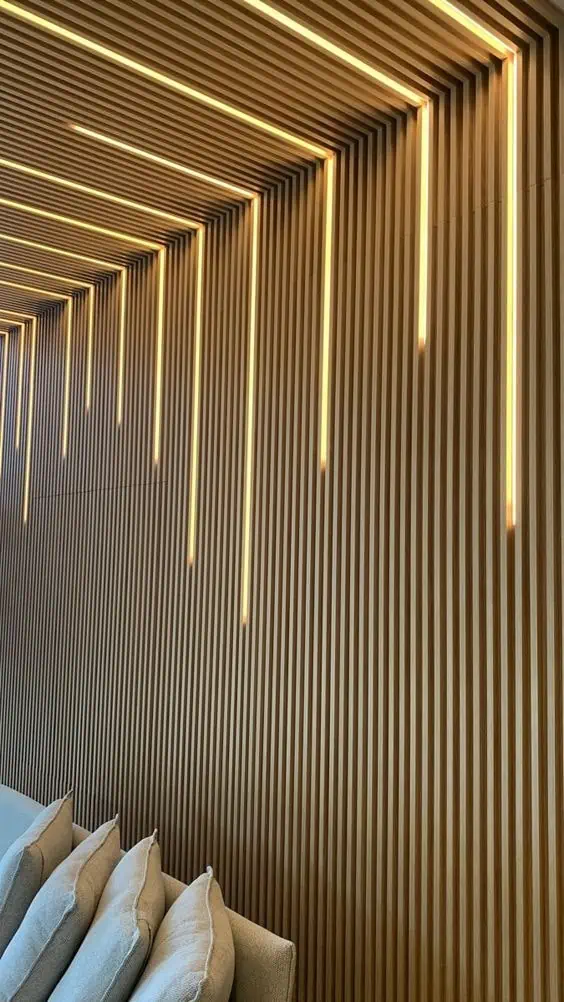
8. Hiding Lights With Cornices And Valances
You can incorporate LED strip lights into your home decor seamlessly by concealing them with cornices and valances. They will create an elegant solution that allows the lights to emit a soft glow without being directly visible. Cornices are typically placed at the junction of walls and ceilings so that it will be easy to hide channels for LED strips. On the other hand, valances offer a stylish curtain-like cover, framing the lights while maintaining a polished appearance. So, if you want to conceal the light source effectively and add a touch of sophistication to the room, you can go with it.
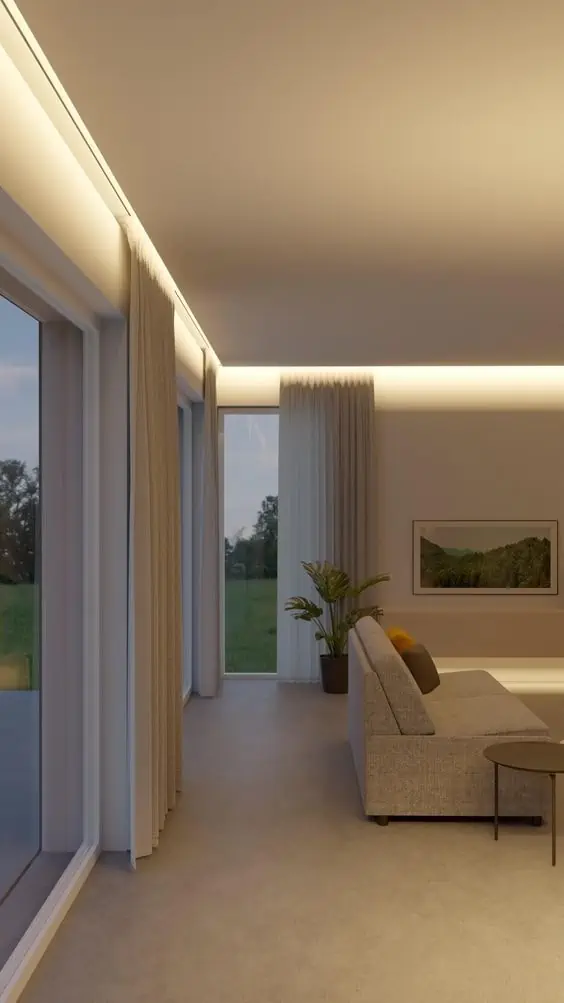
9. Hiding With Mirrors
If the light is installed in your mirror, you often face glaring issues. It’s annoying when the light rays from the LED strips installed aside the mirrors directly hit your eyes. In this case, mounting the LED strips on the back of the mirrors works best to hide them and eliminate the glaring issues. It is straightforward to install and adds a sophisticated look. However, you only need to secure the mirror’s border with the strips that can be placed on the borders or back of them. For this, adhesive or tape, molding, or channel works well to hide the LED strips with mirrors. If you want to install LED strips by yourself with mirrors, read this: How to DIY LED light strips for Mirrors?
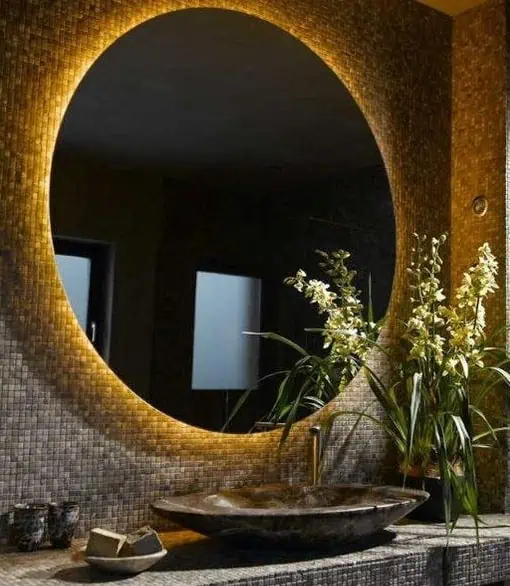
10. Concealing With Wallpaper
Using wallpapers is a creative and stylish method to conceal strip lights. In this case, you need to choose a wallpaper that matches your decor and discreetly tuck the LED strips behind it. Thus, you can get a soft, indirect glow and even brightness. You can use this technique in living rooms, bedrooms, and areas where you want a warm atmosphere.
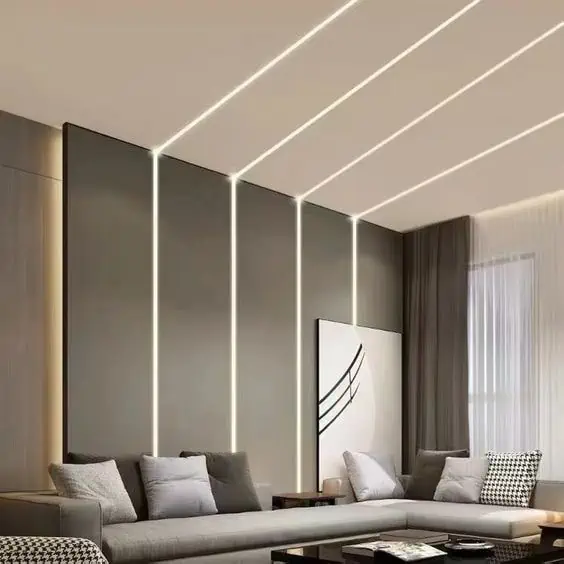
11. At The Bottom And Fanks Of The Room
For a unique touch, you can consider placing LED strips at the bottom and flanks of the room. This adds a subtle glow and also prevents harsh direct lighting. Installing strips along the baseboard or behind furniture can create a floating effect. Also, it gives your space a modern, futuristic vibe. Embrace the versatility by choosing colors that suit your decor. Whether it’s a cozy movie night or a lively gathering, these strategically placed LED strips will set the mood. So, illuminate with style and let your creativity shine.
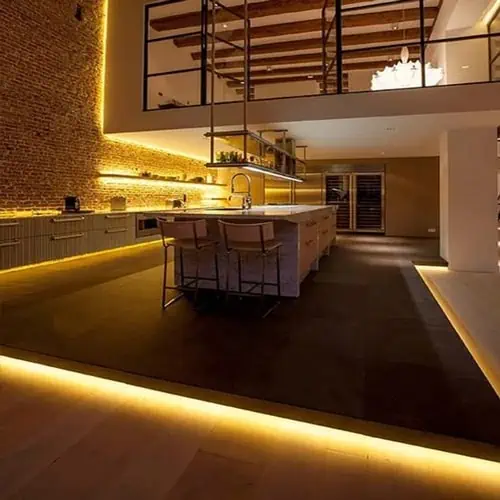
12. At The Foot Of The Bed
If you want to create an intimate and cozy atmosphere, hiding strip lights on the foot or lower side of the bed is a good idea to implement. It will brighten up the floor surrounding the bed, making a warm glow in your bedroom and increasing the sleeping experience. This way, you will add extra design and more comfort. Also, you can hide them on the bed’s headboard and frame facing downwards. This process is easy to apply and works well in different bedroom sizes, like large homes and small apartments. However, you can create a floating effect in your bed by installing the strips beneath the bed and keeping enough space around the edges. Though blue light works best for creating this effect, this light color is not ideal for the bedroom. In this case, I suggest you use our dim-to-warm LED strips. This will allow you to adjust the warm color tones to aid in good sleep.
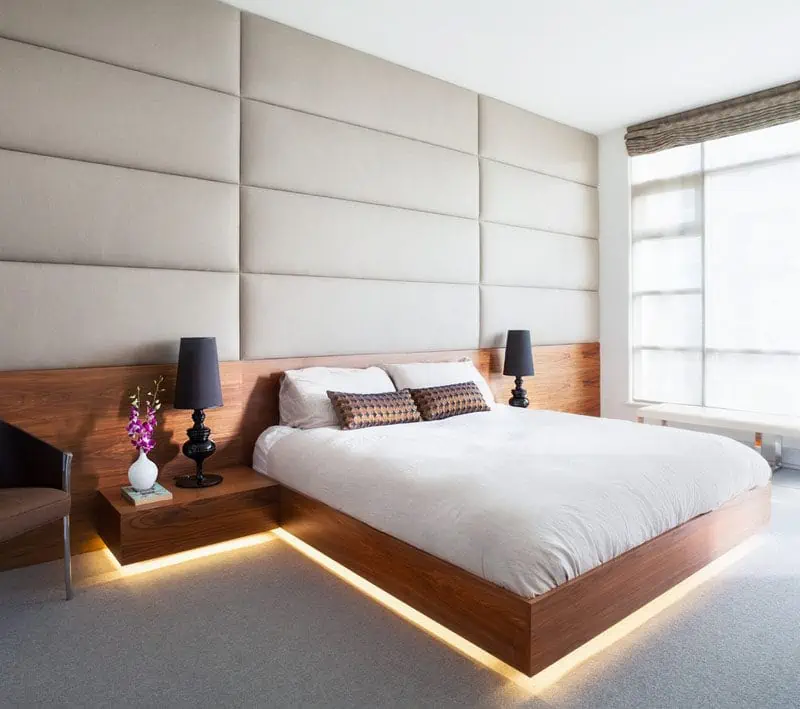
13. Behind The Chairs Or Sofas
Installing LED strips behind the sofas is a fantastic way to hide them. This will help you make your seating experience more comfortable and creative. After hiding them, they will make the seating area more welcoming. And you can give the space an elegant look while hosting a party or arranging a hang-out with friends. Now, you may question if installing LED strips behind furniture like sofas is safe as they have fabric covering. It’s safe; LED strips operate at cool temperatures and don’t get overheated. So, you can use them around furniture without thinking much. To learn about this in detail, check this- Do LED Strip Lights Get Hot?
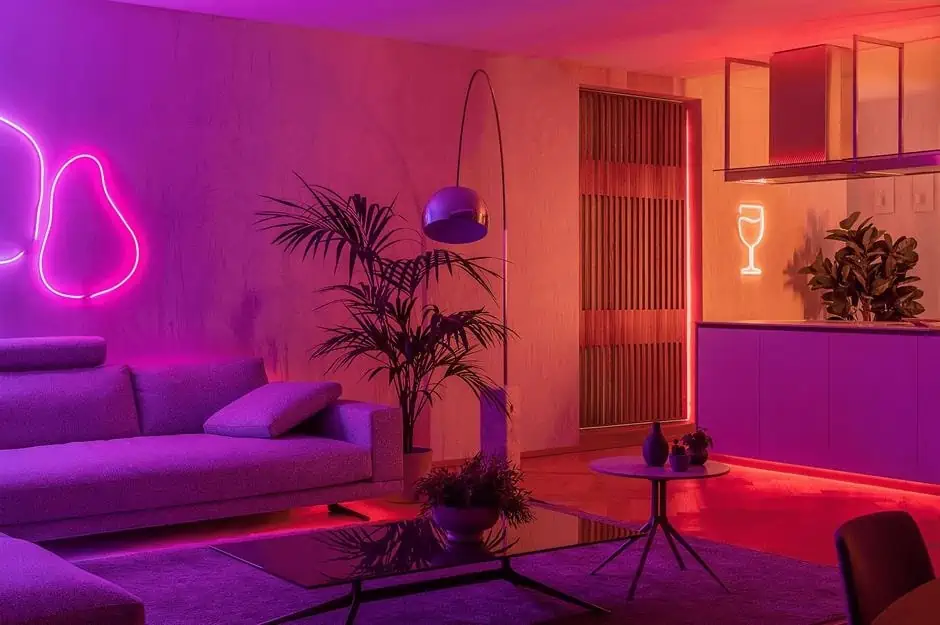
14. On The Door Frame
If you want to hide strips and make your door look more attractive, installing strips to the door frame is a clever move. This is a brilliant way to welcome people into your home. But how to hide them? You can choose a thin LED strip to fit in the gap of the outer door frame. Another option is to create an additional wooden framing and insert the strips to create a hidden effect. Whatever option you select, keep in mind that the lighting should not get hindered while hiding them.
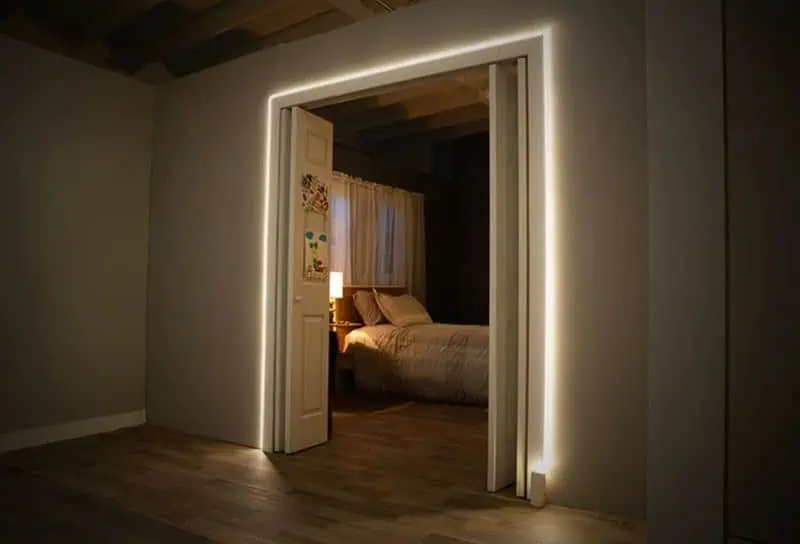
15. Hide LED Strips Beneath The Staircase
The staircase brings you a wide range of opportunities to hide the LED strips. You can install them beneath the steps of the stairs, under the railings, and on the sides of the stairwell. Besides, there are more options to go creative in hiding the strips. And if you have open-case stairs, hiding the LED strips becomes more interesting. All you need to do is install the strips under each stair step. This will create a floating effect and make you feel like the stair is floating in the gravity. Use bright white or bluish LED strips to get the best output from such lighting. Besides indoor stairs, you can also use these techniques to hide the strips of outdoor stairs. However, ensure you use a high IP-rated fixture for outdoor use. Such an installation will hide the strips and bring a sleek accent lighting. The most beneficial thing with this method is that it increases safety, especially at night. So, if you or any family member wakes up at night, they can comfortably use the stairs without any visibility issues. Check this article to learn more about stair light ideas- 16 Stair Lighting Ideas With LED Strip Lights.
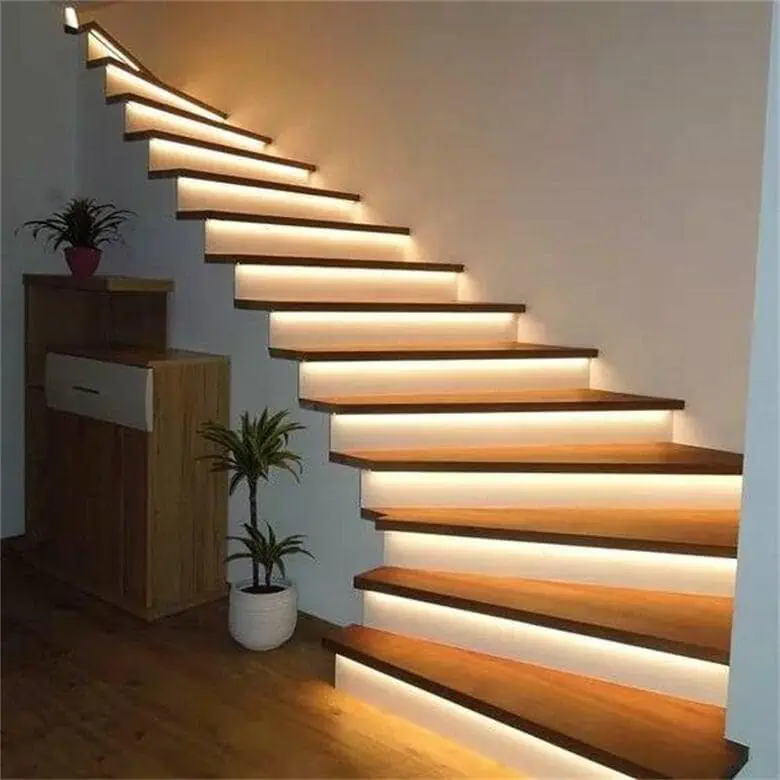
16. Edges Of Coffee Table
You can enhance your coffee table’s beauty by outlining its edges with vibrant LED strips. This simple yet impactful technique adds a touch of modernity to your room. Hence, concealing the strips beneath the table’s perimeter creates a subtle, enchanting glow, perfect for cozy evenings or entertaining guests. It’s a quick and affordable way to infuse style into your decor. However, you can experiment with different colors to match your mood or the occasion. Therefore, from movie nights to dinner parties, this lighting hack turns your coffee table into a focal point.
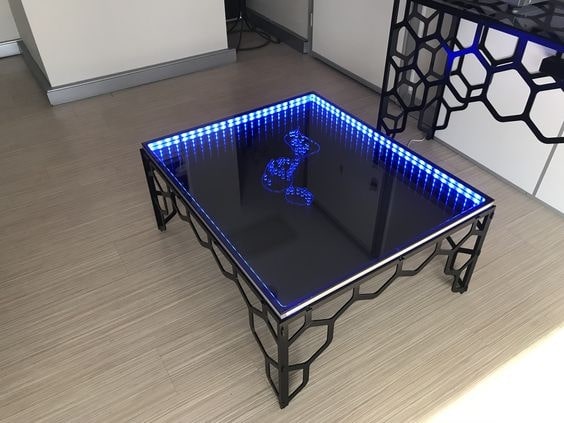
17. Fastened To The Nooks Of Artwork
This is a fantastic way to hide LED strips by illuminating your favorite pieces of art. So, fastening to the nooks of artwork, you can get a seamless blend of aesthetics. Plus, this can produce a soft glow like a spotlight on your paintings or sculptures. Also, it will enhance their beauty while adding a touch of modernity. Grab your LED strips, get creative with those nooks, and let your artwork shine in a new light.
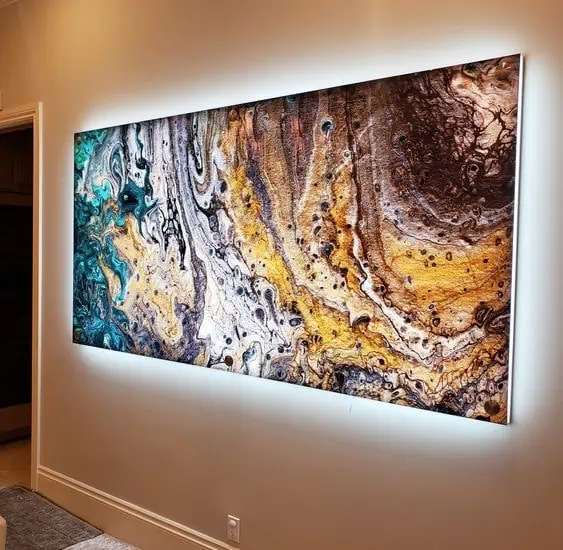
How To Hide LED Light Strip Wires?
Once you are done hiding the LED strips, what do you do with the wires or cables? Please don’t leave them visible! Below, I’m adding some options for hiding your LED strip lights-
- Drop ceilings: You can hide LED strip wires by setting the cables on the ceiling top. And for getting the ideal lighting effect, it’s necessary to use a drop ceiling lip. Hence, you can secure the strips onto the ceiling crown molding, then use a thin cable hider channel to hide it properly. However, the LED strips need to be set near the edge of the drop ceiling. Also, when securing the LED tape, you can attach it to a coving lip, maintaining possible distance from the back wall.
- Hide the wires under shelves and furniture: The most common way you can hide the wirings is simply putting them under the shelves or hiding them beneath the furniture. You can also clip the cables beneath the furniture to secure them.
- Plastic molding and a wooden tray: You can go with plastic molding and wooden trays to hide the strip wires as well. With plastic molding, shape the plastic edges to fit smoothly. But if you choose wooden trays, cut them to match the wall.
- Use a Cable Hider: Cable hiders are also known as cable concealers or cable management systems. They are available in different colors. You can get one that matches the wall or surface of your LED strip installation to hide the unwanted visible cables.
- Hide the LED light strip using a hide plate: As the hide plate comes with holes and hooks, you can use this to hide the LED strips.
- Hide LED light strips with wire nails: This is another excellent option to hide strips. Wire nails come in several sizes; you can use these to set the stripes on the wall.
How To Hide LED Strip Power Supply?
Often, people who plan to set strips in their offices and homes are concerned about hiding LED strip power supply. Fortunately, there are various processes to hide the power source to make a polished and clean look. One possible way to hide the strip power supply is to set it in a concealed location like a cabinet. Place the power source on a shelf or a cabinet and set the strips to the desired location.
Another possible way to conceal the power supply is to set it in the closet or behind furniture. This can be the perfect solution when you do not have a particular area for the strip light and need it to be less visible. Therefore, simply put the strips in a closet or along the back of the furniture to gain this appearance. After that, you have to plug these lights into the power source hidden into those surfaces.
In addition, you can use cable conduits or raceways to hide the strip’s power supply. These metal or plastic channels can be attached to the ceiling or walls and painted to suit the environment’s surface. So, put the strips across the channel and set the power source inside. This method is perfect for a more polished look and if you want to use the LED strip in a more visible place.
Things To Consider While Hiding LED Strip Lights
When hiding LED strips, you need to consider a few things to ensure the lights function correctly and effectively. Let’s look at some of the most common and essential factors–
Cool Power Supply
Power supply is a vital element of strip lights; ensuring this does not overheat is essential. So, while hiding strip lights, you need to install a power source in a cool place, aside from heat-like sunlight. This way, you can make the power supply operate efficiently, and it does not get excessive heat. Otherwise, it can cause damage to the lights and the background materials.
Create Enough Space For Ventilation
When the lights are not positioned in well-ventilated areas, they can build up and damage the lights and the surrounding surfaces. Therefore, while setting strips, you must consider that these lights have ideal room for ventilation, especially when positioned in tight spaces.
Check The Voltage Ratings
LED strips are voltage sensitive and usually run in low voltage ratings. If you install a 12V LED strip to a 24V power source, the strips will get damaged due to overpowering. Again, using a 24V LED strip to a 12V LED strip will not provide enough voltage to get the best light output. These types of LED strips that run at low voltage require an LED driver. Keep these facts in when you are planning to hide the LED strips. However, high-voltage LED strips, which are commonly used for outdoor installation, are also available. Check this to learn more- Low Voltage Vs. High Voltage LED Strips: When to Choose and Why?
Cable Management
Besides hiding the LED strips, you should also emphasize hiding the cables. Don’t end up keeping the messy wirings visible while your lights are hidden well. For this, you can use cable hiders and hide plates, as I mentioned before. Another idea is to clip the wires within the walls and paint them matching the color of the surface. This will blend them within the surroundings, making them less visible. However, you can attempt to create more options; the door for DIY is wide open!
No Access To The Water
Lastly, you need to hide the steps where water is not available. LED strips are electric gadgets, and being near water can damage the lights or lead to safety hazards. So, you need to ensure the place where the strips are set is dry, and there is no chance of water exposure. However, if your strips are of higher IP ratings, they won’t get damaged in contact with water. Yet, it’s better to hide them in a dry place. To learn more about IP ratings, check this- IP Rating: The Definitive Guide.
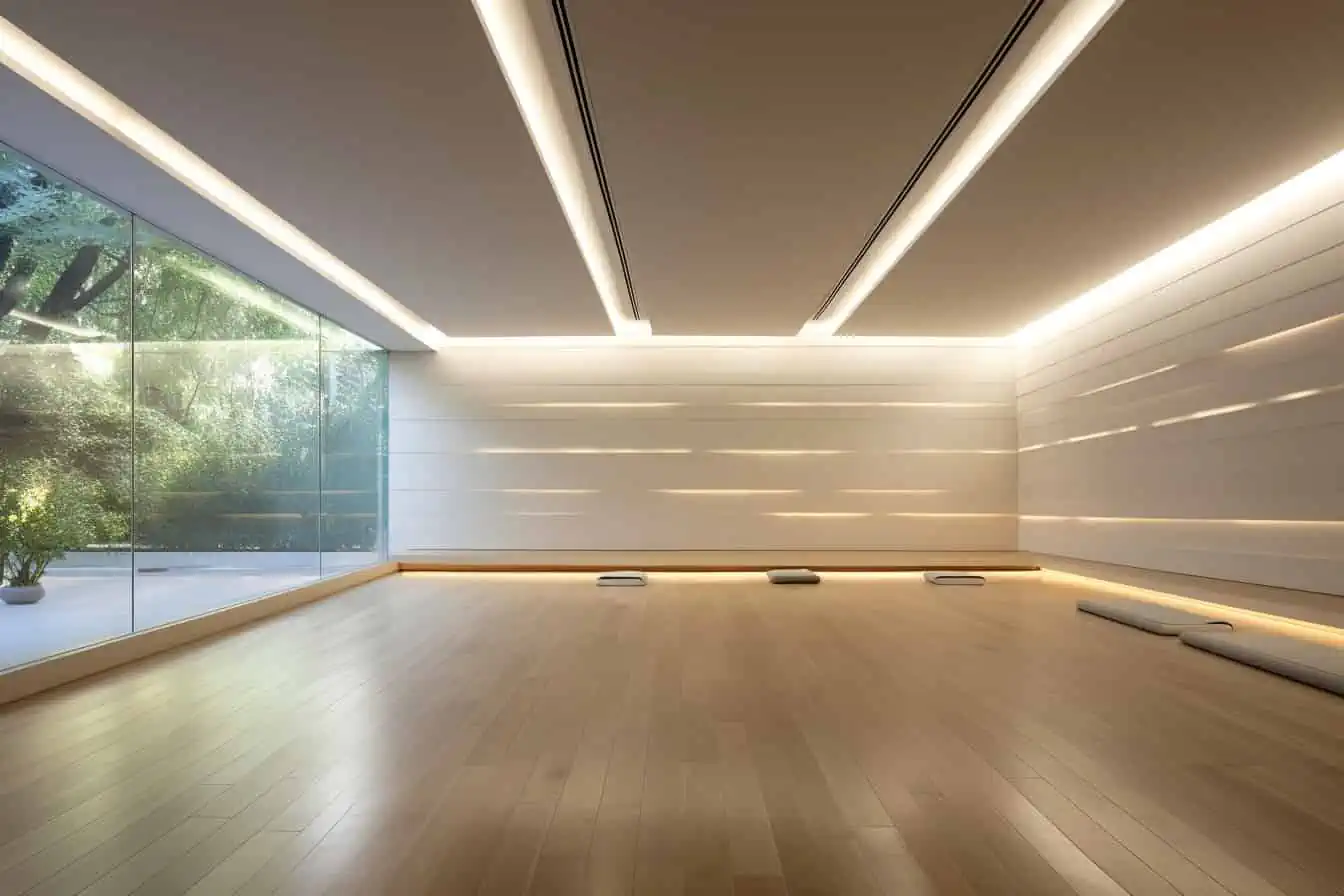
Installing Process For Hidden LED Strip Lights
In the above sections, you have learned about the ways to hide the LED strips. But how do you install them and ensure they are kept hidden? Here is the process to follow-
Step 1: Measure the area where you want to install the lights
To put the LED strip lights, ideally, on a table, cabinet, or frame, you need to measure their length and width first. This way, you will find the correct measurements to fit them in properly and make them hide with the rest of the decor.
Step 2: Buy the right LED Strip Lights
Buying the perfect LED strips is another critical factor. Suppose your installation place is much larger than the strip’s lights; you have to buy a strip extension. These extensions are available for separate purchase. Remove the plastic covers from each end and plug one strip into another to connect them. Also, if you want a hassle-free installation, you can choose strips without a plug. To know the use of these lights, follow this- How To Use LED Strip Lights Without Plug?
Step 3: Locate your power outlets
You need to locate the plug area of your LEDs, which will make it easy for you to hide them. And use neutral-colored electrical tape to place the outlets conveniently. Besides, you can buy long strips of lights that will enable you to extend the desired design to the power source. To understand more about that, read- What Are the Longest LED Strip Lights?
Step 4: Decide how you want to hide the strips
Once you have located the power sources and got the desired LED strips, it’s time to plan how to hide the strips. You can hide them beneath the furniture, like- under the bed, behind the TV or sofa, etc. Besides, you can use a cable hider to hide the strip wires or any prop like a planter or showpiece to hide them. However, cove lighting is the best choice for hiding the strips if you are installing LED strips in the ceiling. After deciding how to hide the strips, you can proceed with your installation process.
Step-5: Size The LED Strips Using A Scissor
Now, clean the surface where you want to install the strips to bring a hidden effect. Then, remove the backing to expose the strip’s adhesive. After that, put the stripes on the target object. If the surface is shorter than your strip, cut it through marked lines to an appropriate length. An inappropriate cut can damage the LED strip. Therefore, you need to ensure the strip is unplugged for safety during cutting or extension. Read this guide to ensure proper cutting- Can You Cut LED Strip Lights and How To Connect: Full Guide.
Step-6: Mount The LED Strips To The Hidden Space
Finally, mount the LED strips to the desired location. You can use different methods to mount them; these are-
- Adhesive backing
- Use clips
- Aluminum channel
The simple process is to go for the adhesive backing. Here, all you need to do is peel off the adhesive backing and press it to the surface. However, for a secure installation, you can use clips. Different types of clips are available- one-side bracket fixing clips, angle adjustable clips, lips with adhesive backing, e-Clips, and more. You can use the one that fits your preference. Again, using a channel, you can hide the LED strips and bring a seamless effect. Diffuser aluminum channels are the best choices for this case. However, bendable channels are also available, and you can use them to hide LED strips in curved locations. To learn more about mounting techniques, check this- Installing LED Flex Strips: Mounting Techniques.
Lastly, once the LED strips are installed in the hidden location, it’s time to power them up. For details on the LED strip installation process, check this- How To Install And Use LED Strip Lights?
Tips For Hiding LED Strip Lights
- Do not place the LED tape near a wall; it can produce light spotting.
- Put LEDs back on a lip in your wall or ceiling.
- You can also use a cable hider if you want to make your home look less cluttered with wires.
- For hiding strip lights, use only certified power sources and connectors to avoid electrical hazards.
- Choose LED strips that match the color scheme of your room or blend with the decor to make them less noticeable when not in use.
- Avoid hiding LED strips near flammable materials to reduce the risk of fire.
- You can achieve a subtle outcome by positioning LED tape behind an edge and directing the lights downward.
- Ensure adequate ventilation to prevent overheating when concealing LED strip lights.
- Securely adhere to the strips to prevent tripping hazards and damage.
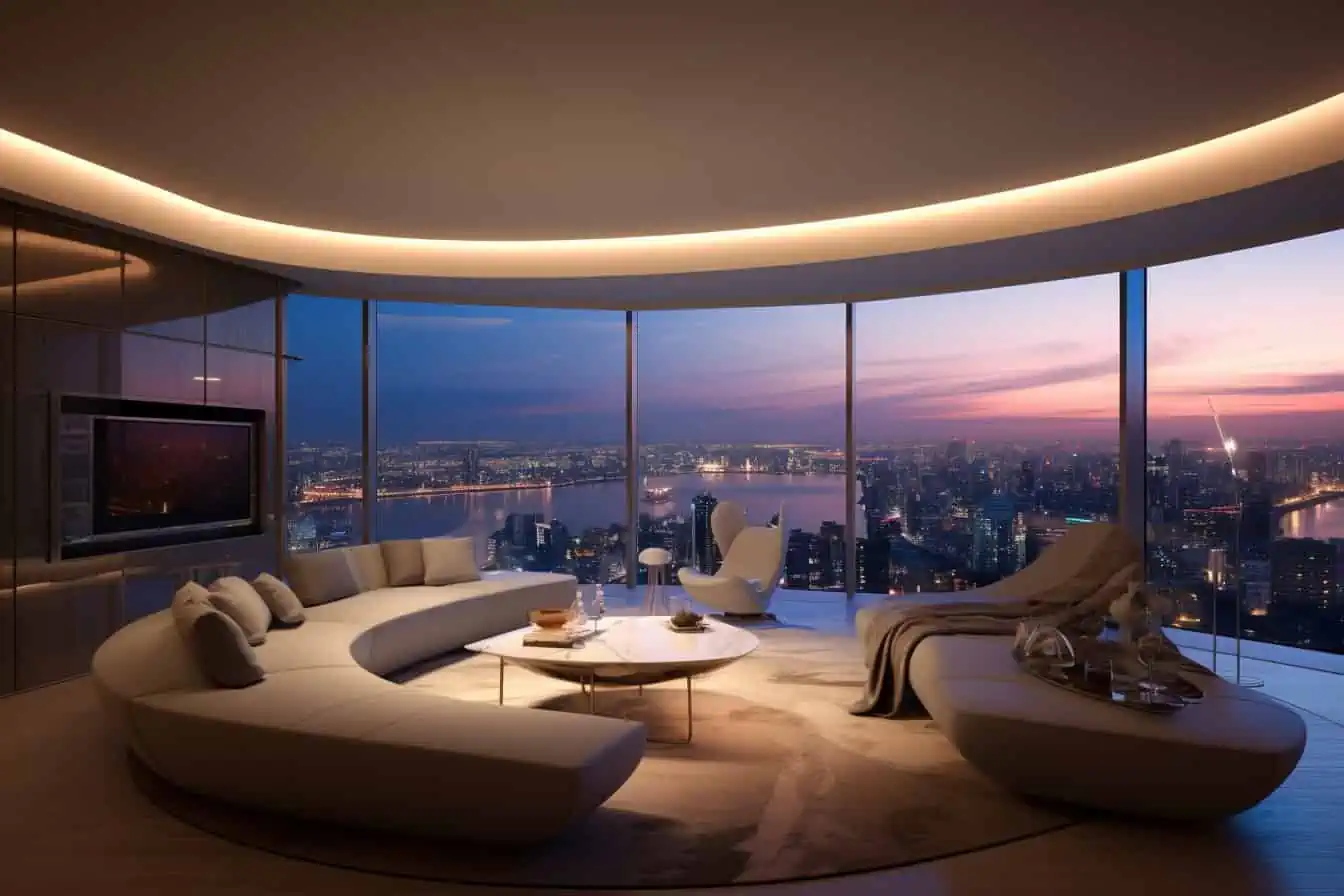
FAQs
Consider using aluminum channels or diffusers to hide exposed LED strip lights for a sleek finish. They will hide the strips and provide a polished look. Besides, you can attempt cove-lighting in the ceiling or install the strips under furniture or cabinets to hide the strips. This will act as an accent lighting and enhance the outlook of your space.
To conceal LED lights perfectly, you can use frosted or colored tape, LED light channels, or install them beneath the furniture. Frosted tape softens the glow, while furniture hides the source. On the other hand, light channels offer a sleek, organized look. Therefore, you can experiment and find what suits your style and space best for a subtle and stylish ambiance.
Covering strip lights is possible with some basic household equipment. For instance, by using painter’s tape, duct tape, and electrical tape, you can ideally cover strips. So, set the strips on any surface; then, choose a tape and secure the lights.
The best way to hide LED strip lights is by using a channel or cove molding. With these, you can create a seamless look that provides charming appeal. This will ensure a polished finish of the strip light while maintaining the desired ambient lighting.
To measure the length of the LED strips for your needs, you first have to take a measuring tape. After that, measure the desired area where you want to install the LED strips. Then, make sure you cover the corners and curves. Once measuring is done, you can cut the strips properly following placement area lengths.
There are many things you can do with leftover LED strips. First of all, you can transform your leftover LED strips into creative decor, such as light-up shelves, frame mirrors, or furniture. Make a mesmerizing headboard or illuminate your workspace. Also, you can connect the leftover LEDs using LED strip connectors and reuse them for any purpose.
An LED strip typically lasts around 50,000 hours, based on product quality and how you use it. This impressive lifespan runs to over five years of continuous use. It makes LED strips a durable and cost-effective lighting solution.
To hide LED strip lights on shelves, consider placing them along the underside or behind the front lip of the shelf. This creates a subtle, ambient glow without direct visibility. At the same time, you can use thin channel mounts or strategically position decorative items to mask the lights while still illuminating your shelves beautifully.
Conclusion
Hiding LED strips eliminates the glaring issues and brings a gentle and sleek indirect illumination. There are many creative ways to hide LED strips if you are a DIY lover. Regarding general lighting, going for cove lighting in the ceiling is the best way to hide your LED strips. Besides, you can mount them beneath the furniture, TV, and shelves to get a hidden illumination. However, to hide the wires of the strips, you can use a cable hider or hide plate. Again, hiding the power source is also essential for a neat light setting. In this case, you can hide them within the furniture or attempt any creative ideas.
To ensure you don’t have to remove the mounted LED strips from the hidden setting too often, considering the quality of the LED strips is essential. And for this, LEDYi is your ultimate solution. Our LED strips come with a 3-5-year warranty. We further have certificates from RoHS, CE, CB, and more. Besides LED strips, we also sell LED strip connectors, aluminum channels, drivers, and controllers that you will require to hide your strips. You can request a free sample to test our products. So, place your order ASAP without any further delay!

